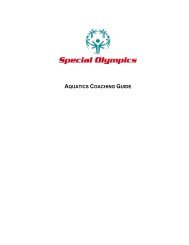BADMINTON Special Olympics Sports Skills Program
BADMINTON Special Olympics Sports Skills Program
BADMINTON Special Olympics Sports Skills Program
You also want an ePaper? Increase the reach of your titles
YUMPU automatically turns print PDFs into web optimized ePapers that Google loves.
Protest Procedures<br />
• Only the registered head coach may file a protest.<br />
• All protests must be submitted in writing on the<br />
appropriate form to the chief referee. Complete the<br />
protest form that is provided in the back of the Official<br />
<strong>Special</strong> <strong>Olympics</strong> Winter <strong>Sports</strong> Rules Book. The<br />
competition jury will review the protest and make a<br />
decision.<br />
• A protest involving the judgment of an official will not<br />
be given consideration.<br />
Equalization of Competition<br />
<strong>Special</strong> <strong>Olympics</strong> believes that every athlete deserves an<br />
equal chance to excel during competition. Thus each competition<br />
division within a given event must be structured so<br />
that every athlete/team in the division has a reasonable<br />
chance to excel according to accurate records of previous<br />
performance or trial heats and, when relevant, grouping by<br />
age and gender.<br />
Glossary of Badminton Terms<br />
Alley — Playing area between the singles and doubles<br />
sidelines.<br />
Backhand — A stroke hit on the nondominant side of a<br />
player’s body.<br />
Backswing — The segment of the swing that takes the racket<br />
back into the early hitting position prior to swinging the<br />
racket forward into the hit.<br />
Baseline — The back boundary line of the court.<br />
Bird — The object used to strike during play. Also called a<br />
shuttle or shuttlecock.<br />
Clear — A high, deep shot that would land near the<br />
opponent’s baseline.<br />
Crosscourt — Refers to the direction of a shot that is in a<br />
diagonal position from the point of contact with the shuttle.<br />
Double Hit — When the shuttle is struck twice during the<br />
same stroke. This is classified as a fault.<br />
Doubles Service Court — The space that a legal serve must<br />
fall into during doubles play. It is the space inclusive of and<br />
between the short service line, the long service line for<br />
doubles, the centerline, and the doubles sideline.<br />
Drive — A hard hit shuttle that usually takes a flat trajectory<br />
across the net.<br />
Drop Shot — An overhead or an underhand stroke that is hit<br />
in such a way that it lands close to the net on the opponent’s<br />
side of the court.<br />
<strong>Special</strong> <strong>Olympics</strong> Badminton <strong>Sports</strong> <strong>Skills</strong> <strong>Program</strong><br />
Fault — A violation of the rules of play.<br />
Follow-through — That portion of any stroke after the<br />
shuttle is struck.<br />
Forehand — A stroke that is executed from the dominant or<br />
racket hand side of the body.<br />
Forehand Grip — Also called the handshake grip, which is<br />
used for all forehand strokes.<br />
Game — A contest that ends with a specific number of<br />
points for one player. Usually 11 points for women’s singles<br />
and 15 points for all other events.<br />
Hairpin Drop Shot — A soft underhand net drop executed<br />
from very close to the net.<br />
Hands Down — Refers to the first or second server on the<br />
same team during doubles play. One hand down indicates that<br />
one partner has lost his or her serve. Two hands down means<br />
that the second partner has lost his or her serve. While serv i n g ,<br />
these are referred to as first hand or second hand. Two hands<br />
d own means that the opponents serve the next bird.<br />
International Badminton Federation (I.B.F.) — The world<br />
governing body for the sport of badminton.<br />
Let — To replay the point.<br />
Match — Usually consists of two out of three games.<br />
Match Point — The point where a match could be won.<br />
Overhead — Any shot executed above the head level.<br />
Rally — An exchange of consecutive hits between two<br />
players (singles) or four players (doubles) until the bird lands<br />
out of bounds or is not returned back over the net.<br />
Ready Position — The body position of readiness to begin a<br />
game or practice rally. This is usually a position where the<br />
knees are bent and the racket is up and ready for play.<br />
Receiver — The player who must return the serve.<br />
Server — The player who hits the serve.<br />
S e rvice Ove r — The server has lost his serve to the opponent.<br />
Setting — An option that players have at a given point in any<br />
game. Setting options occur at 10-10 in women’s singles and<br />
at 14-14 for all other events. Two options are available to the<br />
receiver if a game is tied at 10 all or 14 all. Option 1(no set)<br />
means whoever gets the next point wins the game. Option 2<br />
(set to 3) means that the first person or team who gets the<br />
next 3 points wins the game.<br />
Short Service Line — The boundary line that the bird must<br />
land on or beyond during the execution of the serve.<br />
5 3

















